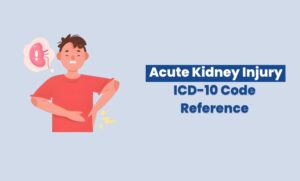Jaundice, marked by the yellowing of the skin and eyes, is more than just a symptom—it’s an indicator of underlying health conditions ranging from liver diseases to blood disorders. Accurate diagnosis is crucial for effective treatment, and this is where ICD-10 codes for jaundice come into play.
These standardized codes, including R17 and those for obstructive jaundice and hyperbilirubinemia, help healthcare professionals pinpoint causes, streamline billing, and enhance global health data.
Read our guide to understand the significance of these codes and how they support better patient care.
What is Jaundice?
Jaundice is a medical condition characterized by the yellowing of the skin and whites of the eyes. This occurs due to an excess of bilirubin, a yellow pigment produced during the breakdown of red blood cells.
While jaundice itself is not a disease, it serves as a vital indicator of underlying health issues, such as liver diseases, bile duct obstructions, or blood disorders.
The Importance of ICD-10 Codes for Jaundice
ICD-10 codes are the backbone of modern healthcare documentation. These standardized codes enable clear communication among healthcare professionals, facilitate insurance billing, and contribute to global health statistics.
For jaundice, specific codes like R17 – Unspecified Jaundice are used when the exact cause isn’t determined. Other codes are tailored to particular conditions, such as obstructive jaundice or hyperbilirubinemia, helping medical teams classify and treat each case effectively.
Main Types of Jaundice and Their ICD-10 Codes
1. Obstructive Jaundice
Obstructive jaundice arises when bile flow is blocked, often due to gallstones, tumors, or bile duct abnormalities. This blockage prevents bilirubin from being excreted, leading to its accumulation in the blood.
Key ICD-10 Codes for Obstructive Jaundice:
- K83.0 – Obstruction of the bile duct
- K83.1 – Hydrops of the gallbladder
- C24.0 – Malignant neoplasm of the extrahepatic bile duct
- C22.0 – Liver cell carcinoma
- K80.6 – Other bile duct obstructions not involving gallstones
Accurate coding ensures that obstructive jaundice is addressed with targeted diagnostic tests and interventions, such as imaging studies or surgical procedures.
2. Pre-Hepatic Jaundice
Also known as hemolytic jaundice, this type occurs when excessive breakdown of red blood cells overwhelms the liver’s capacity to process bilirubin. Common causes include inherited blood disorders or autoimmune conditions.
Key ICD-10 Codes for Pre-Hepatic Jaundice:
- D55.0 – G6PD Deficiency Anemia
- D56.0 – Thalassemia
- D57.0 – Sickle-Cell Anemia with Crisis
- D59.1 – Autoimmune Hemolytic Anemias
These codes help healthcare providers identify and document conditions leading to pre-hepatic jaundice, allowing for appropriate treatments like transfusions or medication adjustments.
3. Hepatic Jaundice
Hepatic jaundice results from liver dysfunction, which impairs its ability to process and excrete bilirubin. Conditions like hepatitis, cirrhosis, or liver abscesses are common culprits.
Key ICD-10 Codes for Hepatic Jaundice:
- K70.0 – Alcoholic Fatty Liver
- B15.9 – Acute Hepatitis A Without Hepatic Coma
- B18.2 – Chronic Viral Hepatitis C
- K71.0 – Toxic Liver Disease with Cholestasis
- K73.0 – Chronic Hepatitis, Not Elsewhere Classified
These codes ensure precise diagnosis and enable healthcare providers to implement effective treatment strategies, such as antiviral therapies or lifestyle modifications.
ICD-10 Code for Hyperbilirubinemia
Hyperbilirubinemia, a condition of elevated bilirubin levels in the blood, is often a precursor to jaundice. Its accurate classification is vital for neonatal and adult cases alike.
Key ICD-10 Codes for Hyperbilirubinemia:
- P59.9 – Neonatal jaundice from other and unspecified causes
- E80.6 – Other disorders of bilirubin metabolism
- P58.0 – Hemolytic disease of the newborn due to isoimmunization
By documenting hyperbilirubinemia correctly, healthcare providers can initiate timely interventions, such as phototherapy for newborns or medication adjustments in adults.
How ICD-10 Codes Enhance Diagnosis and Treatment
ICD-10 codes play a transformative role in the diagnosis and management of jaundice. By categorizing the condition based on its cause, these codes provide clarity for healthcare providers, enabling them to make more informed decisions.
Here’s how they help:
1. Differentiating Types of Jaundice:
Whether the jaundice is obstructive, pre-hepatic, or hepatic, ICD-10 codes like R17 and disease-specific codes help pinpoint the root cause. For instance, K83.0 for bile duct obstruction provides a clear path for diagnostic imaging and surgical planning.
2. Facilitating Targeted Treatments:
Accurate coding ensures patients receive appropriate care. For example, identifying P59.9 (neonatal jaundice from unspecified causes) helps initiate phototherapy in newborns, while K71.0 (toxic liver disease with cholestasis) guides detoxification protocols.
3. Improving Communication and Documentation:
Standardized codes enhance communication between specialists, insurers, and researchers. They also simplify record-keeping for future patient care and billing.
4. Advancing Global Health Research:
Aggregated ICD-10 data supports global studies on jaundice prevalence, outcomes, and treatment efficacy, improving medical practices worldwide.
Conclusion
Jaundice, while commonly recognized, is a multifaceted condition with diverse causes. By utilizing the correct ICD-10 codes for jaundice, such as R17, K83.0, or P59.9, healthcare providers can ensure precise diagnoses, targeted treatments, and efficient documentation. These codes not only improve patient outcomes but also enhance communication across the healthcare ecosystem and contribute to global medical research.
Accurate coding is more than a technicality—it’s a cornerstone of quality care. Whether diagnosing obstructive jaundice or managing neonatal hyperbilirubinemia, ICD-10 codes empower healthcare professionals to provide the best possible care.





